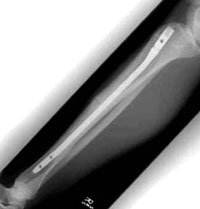Understanding variety of lower-leg stress fractures essential to proper treatment
The location and severity of lower-leg stress fractures ultimately dictate their management.

Lower-leg stress fractures vary greatly depending on location and severity, and special care must be taken to determine which kind of fracture an athlete has before treatment and recovery can begin.
“The take-home point of this talk is when you are trying to figure out when to send an athlete back from a stress fracture, do not lump all stress fractures into the same category,” Thomas J. Gill, MD, said at the 2009 Annual Meeting of the American Orthopaedic Society for Sports Medicine.
“There are different types, and if you can identify the category of the stress fracture, that will help you decide when to allow a return to play.”
|
Radiograph showing a tibial stress fracture. Images: Gill TJ |
Fatigue vs. insufficiency
Gill noted that 20% of runners get stress fractures, and 95% of those cases are in the lower extremities. He also noted that not all shin and leg pain indicates a stress fracture.
“The reason you get stress fractures is usually an imbalance or an abrupt increase in either the duration or the intensity of your activity,” he said.
The first measure of determining how to properly treat any one stress fracture is to determine whether it is a fatigue fracture – considered by Gill to be abnormal stress on a normal bone, typically found in athletes or military recruits – or an insufficiency fracture, also known as normal stress on an abnormal bone.
High vs. low risk
For a quicker return to athletic play, Gill said the most important factor is to figure out whether the fracture in question is high-risk or low-risk.
“Low-risk fractures are unlikely to progress, so an in-season athlete can continue to play even though he or she has a stress fracture,” he said. “High-risk fractures are different. They can progress to complete fractures. These are season-ending injuries.”
Low-risk fractures occurring out of season can typically be treated with 4 to 8 weeks of rest from the activity, Gill said, although that depends on where along the lower extremity the fracture is and the risk involved in progressing the fracture.
Pain
When the patient is pain-free, he or she may make a gradual return to impact activity. In-season pain with no functional limitations for a low-risk fracture means the athlete can continue at a level that does not increase his or her symptoms. This approach also helps to prevent deconditioning of the athlete. Pain with functional limitations requires activity modifications until the pain decreases to a functional level, Gill said.
|
|
|
Low-risk stress fractures include those to the compression side of the femoral neck, some tibia fractures and fractures to the distal fibula and calcaneus.
High-risk fractures should be treated much more seriously, and the patient should only return to play after the injury has completely healed radiographically and clinically, Gill said. These must be treated with individualized management and, if necessary, surgery.
High-risk stress fractures include tension-sided fractures of the femoral neck, patella fractures, medial malleolus fractures, some tibia fractures and fractures to the tarsal navicular and fifth metatarsal, he said.
For more information:
- Thomas J. Gill, MD is chief of sports medicine at Massachusetts General Hospital and associate professor of orthopedic surgery at Harvard Medical School in Boston. He can be reached at 15 Parkman St., Boston, MA 02114; 617-726-7797; e-mail: tgill@partners.org. He receives grant support from Breg, Bledsoe Brace, Donjoy, Smith & Nephew Endoscopy and DePuy Mitek, and is a consultant for Conmed.
Reference:
- Gill TJ. Lower leg stress fractures. Presented at the American Orthopedic Society for Sports Medicine Annual Meeting. July 9-12, 2009. Keystone, Colo.



